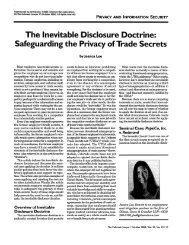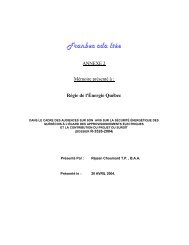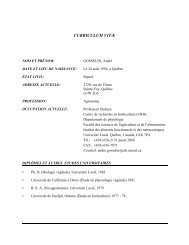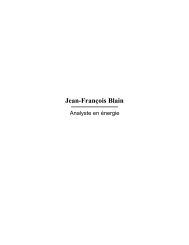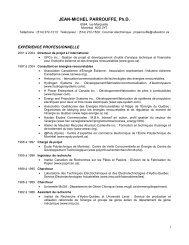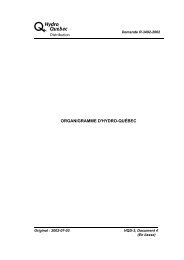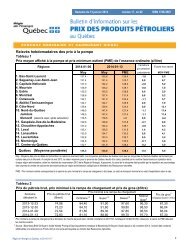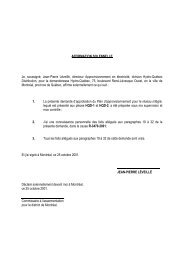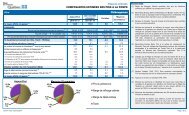unofficial english translation only the french text of decision d-2013 ...
unofficial english translation only the french text of decision d-2013 ...
unofficial english translation only the french text of decision d-2013 ...
You also want an ePaper? Increase the reach of your titles
YUMPU automatically turns print PDFs into web optimized ePapers that Google loves.
UNOFFICIAL ENGLISH TRANSLATIONONLY THE FRENCH TEXT OF DECISIOND-<strong>2013</strong>-036 HAS LEGAL FORCE
D E C I S I O NQUÉBECRÉGIE DE L’ÉNERGIED-<strong>2013</strong>-036 R-3809-2012 March 5, <strong>2013</strong>Phase 2PRESENT:Marc TurgeonJean-François ViauFrançoise GagnonCommissionersGaz Métro Limited PartnershipApplicantandIntervenors listed belowDecision – Application concerning <strong>the</strong> setting <strong>of</strong> <strong>the</strong> rate<strong>of</strong> returnApplication for approval <strong>of</strong> <strong>the</strong> supply plan and changes toConditions <strong>of</strong> Service and Rates <strong>of</strong> Gaz Métro LimitedPartnership effective October 1, 2012 – Phase 2
D-<strong>2013</strong>-036, R-3809-2012 Phase 2, <strong>2013</strong> 03 05 5Intervenors- Canadian Federation <strong>of</strong> Independent Business (Québec chapter) (CFIB);- Groupe de recherche appliquée en macroécologie (GRAME);- Industrial Gas Users Association (IGUA);- Option consommateurs (OC);- Regroupement des organismes environnementaux en énergie (ROEÉ);- Regroupement national des conseils régionaux de l’environnement du Québec(RNCREQ);- Stratégies énergétiques and Association québécoise de lutte contre la pollutionatmosphérique (S.É./AQLPA);- TransCanada Energy Ltd. (TCE);- TransCanada Pipelines Limited (TCPL);- Union des consommateurs (UC);- Union des municipalités du Québec (UMQ).
6 D-<strong>2013</strong>-036, R-3809-2012 Phase 2, <strong>2013</strong> 03 051. INTRODUCTION[1] On July 6, 2012, Gaz Métro Limited Partnership (“Gaz Métro” or “<strong>the</strong>distributor”) filed an application with <strong>the</strong> Régie de l’énergie (“<strong>the</strong> Régie”) for approval <strong>of</strong>its supply plan and changes to its Conditions <strong>of</strong> Service and Tariff effectiveOctober 1, 2012 1 . It proposes to deal with this file in two phases.[2] On July 19, 2012, <strong>the</strong> Régie issued <strong>decision</strong> D-2012-084 approving <strong>the</strong> proposalfrom Gaz Métro to proceed with review <strong>of</strong> <strong>the</strong> application in two phases.[3] On November 23 and December 18, 2012, <strong>the</strong> Régie handed down its <strong>decision</strong> onphase 1 <strong>of</strong> <strong>the</strong> application except for items relating to <strong>the</strong> performance indicator 2 .[4] On December 14, 2012, <strong>the</strong> distributor filed a “second re-amended application” 3with <strong>the</strong> Régie presenting <strong>the</strong> various items listed as part <strong>of</strong> <strong>the</strong> application’s secondphase, namely:I. Sales Development;II.III.IV.Asset management;Investments;Financial Strategy;V. Determination <strong>of</strong> revenue required, including <strong>the</strong> cost <strong>of</strong> distributionservice;VI.VII.Substitution and Energy Efficiency;Cost Allocation;VIII. Vision, strategy and Rate Schedules;IX.Changes to Conditions <strong>of</strong> Service and Tariff;X. Document entitled Conditions <strong>of</strong> Service and Tariff.[5] The findings sought by <strong>the</strong> distributor with regard to <strong>the</strong> rate <strong>of</strong> return described inSection IV <strong>of</strong> <strong>the</strong> “Second re-amended application” relating to <strong>the</strong> Financial Strategy areas follows:123Application under sections 31(1), 32, 48, 49, 52, 72 and 74.Decisions D-2012-158 and D-2012-175.Exhibit B-0123.
D-<strong>2013</strong>-036, R-3809-2012 Phase 2, <strong>2013</strong> 03 05 7“ DECLARE that <strong>the</strong> rate <strong>of</strong> return established by applying <strong>the</strong> formula for <strong>the</strong>year <strong>2013</strong> is not reasonable;ALLOW a rate <strong>of</strong> return <strong>of</strong> 9.3% on <strong>the</strong> common equity <strong>of</strong> Gaz Métro for ratedeterminationpurposes; ” [Gaz Métro emphasis]2. PROCEDURAL DECISIONS[6] On January 14, <strong>2013</strong>, <strong>the</strong> Régie handed down procedural <strong>decision</strong> D-<strong>2013</strong>-003, inwhich it set <strong>the</strong> timetable for phase 2, specifically with respect to <strong>the</strong> application todetermine <strong>the</strong> distributor’s rate <strong>of</strong> return (<strong>the</strong> Application).[7] In that <strong>decision</strong>, <strong>the</strong> Régie laid out a specific approach with respect to <strong>the</strong>Application. A review <strong>of</strong> <strong>the</strong> relevant paragraphs would seem appropriate:“ [20] Following a prima facie examination <strong>of</strong> <strong>the</strong> application, <strong>the</strong> Régie wondersif <strong>the</strong> con<strong>text</strong> described previously and <strong>the</strong> reasons given by <strong>the</strong> distributor justifya fur<strong>the</strong>r “in-depth review” <strong>of</strong> its rate <strong>of</strong> return.[21] In its <strong>decision</strong> D-2011-182, <strong>the</strong> Régie determined that a reasonable rate <strong>of</strong>return to be authorized for <strong>the</strong> distributor was in <strong>the</strong> range <strong>of</strong> 7.71% to 9.60%. Itnoted that <strong>the</strong> rate <strong>of</strong> return <strong>of</strong> 7.92% generated by <strong>the</strong> AAF falls within thatrange.[22] However, <strong>the</strong> Régie notes that <strong>the</strong>re is indeed a significant gap between <strong>the</strong>anticipated risk-free rate that it had used in its <strong>decision</strong> D-2011-182 to determine<strong>the</strong> distributor’s authorized rate <strong>of</strong> return and <strong>the</strong> average <strong>of</strong> <strong>the</strong> anticipated riskfreerates established in August 2012 that are used in applying <strong>the</strong> AAF. Therange used last year was between 3.91% and 4.50%, whereas <strong>the</strong> August 2012average was 2.7%.[23] Again, concerned with <strong>the</strong> regulatory costs associated with applications todetermine <strong>the</strong> distributor’s rate <strong>of</strong> return, and for reasons <strong>of</strong> efficiency andeffectiveness, <strong>the</strong> Régie feels that an approach tailored to <strong>the</strong> circumstances andone that respects both <strong>the</strong> interests <strong>of</strong> Gaz Métro and its customers needs to beadopted.
8 D-<strong>2013</strong>-036, R-3809-2012 Phase 2, <strong>2013</strong> 03 05[24] Therefore, for <strong>2013</strong>, <strong>the</strong> Régie feels it would be appropriate to suspendapplication <strong>of</strong> <strong>the</strong> AAF and maintain <strong>the</strong> rate <strong>of</strong> return on common equity set in2012, that is, 8.90%.[25] The Régie wishes to hear from <strong>the</strong> distributor and <strong>the</strong> o<strong>the</strong>r stakeholders onthis proposal. ”[8] In that same <strong>decision</strong>, <strong>the</strong> Régie called <strong>the</strong> participants to a hearing on thisproposal. The hearing took place on February 14, <strong>2013</strong>.[9] On February 12, <strong>2013</strong>, <strong>the</strong> Régie handed down procedural <strong>decision</strong> D-<strong>2013</strong>-024,which deals with request for information No. 2 from OC to <strong>the</strong> distributor. Morespecifically, in response to <strong>the</strong> request from OC for examination and cross-examinationregarding <strong>the</strong> information that <strong>the</strong> distributor is required to produce, <strong>the</strong> Régie explained<strong>the</strong> following procedure that was to apply at <strong>the</strong> hearing on February 14, <strong>2013</strong>:“ [6] The purpose <strong>of</strong> <strong>the</strong> February 14, <strong>2013</strong> hearing is to hear <strong>the</strong> positions <strong>of</strong> <strong>the</strong>participants regarding <strong>the</strong> proposed handling <strong>of</strong> <strong>the</strong> issue <strong>of</strong> <strong>the</strong> distributor’sauthorized rate <strong>of</strong> return stated by <strong>the</strong> Régie in its procedural <strong>decision</strong>D-<strong>2013</strong>-003. The Régie <strong>the</strong>refore feels that <strong>the</strong>re is no need to hear witnesses orto proceed with cross-examinations. Therefore, each participant will be allowedto present whatever information it deems necessary through its counsel. ”3. LEGAL CONTEXT[10] As it indicated previously in procedural <strong>decision</strong> D-<strong>2013</strong>-003, <strong>the</strong> Régie proposesto suspend <strong>the</strong> Automatic Adjustment Formula (AAF) that was established in its <strong>decision</strong>D-2011-182 and maintain <strong>the</strong> rate <strong>of</strong> return on common equity that was set in 2012, thatis, 8.90% (“<strong>the</strong> Proposal”).
D-<strong>2013</strong>-036, R-3809-2012 Phase 2, <strong>2013</strong> 03 05 9[11] It seems an opportune time to review <strong>the</strong> events that led to this Proposal, as well as<strong>the</strong> jurisdictions and powers that are accorded to <strong>the</strong> Régie under <strong>the</strong> Act respecting <strong>the</strong>Régie de l’énergie 4 (“<strong>the</strong> Act”) and <strong>the</strong> Regulation respecting <strong>the</strong> procedure <strong>of</strong> <strong>the</strong> Régiede l’énergie 5 (“<strong>the</strong> Regulation”).[12] Between 2007 and 2012, <strong>the</strong> Régie was asked, on five occasions, to decide on <strong>the</strong>distributor’s rate <strong>of</strong> return 6 . Under <strong>the</strong> terms <strong>of</strong> <strong>the</strong> most recent application, <strong>the</strong> Régie set<strong>the</strong> rate <strong>of</strong> return at 8.90%, and after reviewing <strong>the</strong> applications and associated regulatorycosts, it approved an AAF for three years, starting with <strong>2013</strong>. The Régie also allowed <strong>the</strong>opportunity for <strong>the</strong> distributor to file ano<strong>the</strong>r request “if <strong>the</strong> situation so warrants” 7 :“ [305] Without wishing to prevent Gaz Métro from filing an application withrespect to <strong>the</strong> rate <strong>of</strong> return if <strong>the</strong> situation so warrants, <strong>the</strong> Régie believes that <strong>the</strong>effectiveness, efficiency and stability <strong>of</strong> <strong>the</strong> regulatory process support application<strong>of</strong> <strong>the</strong> AAF for a reasonably lengthy period before <strong>the</strong> factors in <strong>the</strong> formula arereviewed or before <strong>the</strong> method by which <strong>the</strong> ROE is established is reconsidered.Therefore, <strong>the</strong> Régie approves application <strong>of</strong> <strong>the</strong> new AAF for a period <strong>of</strong> threeyears, starting with <strong>the</strong> <strong>2013</strong> rate case. ” [emphasis added][13] However, right from <strong>the</strong> first year <strong>the</strong> AAF was in effect, <strong>the</strong> distributor, withouteven questioning its relevance, alleged that <strong>the</strong> situation was such that <strong>the</strong> Régie neededto take ano<strong>the</strong>r look at its rate <strong>of</strong> return 8 :“ Gaz Métro remains favourable to maintaining <strong>the</strong> existing automatic adjustmentformula. While <strong>the</strong> existence <strong>of</strong> such formulae over <strong>the</strong> past few years has notproduced results that Gaz Métro feels are reasonable, it feels that it is in <strong>the</strong> bestinterests <strong>of</strong> all stakeholders that it be maintained in <strong>the</strong> future. In effect, GazMétro feels that in a situation <strong>of</strong> relative market stability, <strong>the</strong> Formula providesuseful information on <strong>the</strong> type <strong>of</strong> adjustment that needs to be made to <strong>the</strong>authorized rate <strong>of</strong> return. ”[14] In order to justify a new study, <strong>the</strong> distributor claimed that applying <strong>the</strong> AAFresulted in a rate <strong>of</strong> return <strong>of</strong> 7.92% on common equity for <strong>2013</strong>. It felt that this rate45678R.S.Q., c. R-6.01.(2006) 138 G.O. II, 2279.Files R-3630-2007 (D-2007-116), R-3662-2008 (D-2008-140), R-3690-2009 (D-2009-152), R-3752-2011(D-2011-182) and R-3809-2012.File R-3752-2011, <strong>decision</strong> D-2011-182.Exhibit B-0156, page 5.
10 D-<strong>2013</strong>-036, R-3809-2012 Phase 2, <strong>2013</strong> 03 05cannot be described as reasonable, based on <strong>the</strong> three criteria recognized by <strong>the</strong> courts forestablishing <strong>the</strong> standard for a reasonable return. More specifically, Gaz Métro considersthat <strong>the</strong> criterion <strong>of</strong> comparable investment has not been met, because <strong>of</strong> <strong>the</strong> instability in<strong>the</strong> financial markets, primarily <strong>the</strong> drop in risk-free rates. So <strong>the</strong> distributor has asked <strong>the</strong>Régie to set <strong>the</strong> rate <strong>of</strong> return for <strong>the</strong> <strong>2013</strong> at 9.3% 9 .[15] The Régie’s jurisdiction over <strong>the</strong> rate <strong>of</strong> return allowed to <strong>the</strong> distributor isdescribed in section 32 <strong>of</strong> <strong>the</strong> Act as follows:“ 32. The Régie, on its own initiative or on <strong>the</strong> application <strong>of</strong> any interestedperson, may(1) determine <strong>the</strong> rate <strong>of</strong> return <strong>of</strong> <strong>the</strong> electric power carrier or <strong>the</strong> electric powerdistributor or <strong>of</strong> a natural gas distributor;[…] ” [emphasis added][16] Under this provision, in order to set <strong>the</strong> distributor’s rate <strong>of</strong> return, <strong>the</strong> Régie mayact “on its own initiative or on <strong>the</strong> application <strong>of</strong> any interested person”. Since thisprovision is not mentioned in section 25 <strong>of</strong> <strong>the</strong> Act, <strong>the</strong> Régie is <strong>the</strong>refore not required tohold a public hearing:“ 25. The Régie shall hold a public hearing:(1) when examining an application under section 48, 65, 78 or 80;(2) when determining <strong>the</strong> elements making up operating costs and determining anamount pursuant to section 59;(2.1) (subparagraph repealed);(3) when so required by <strong>the</strong> Minister, on any energy matter.The Régie may call a public hearing on any matter within its jurisdiction. ”[17] In order to avoid any ambiguity regarding <strong>the</strong> Régie’s jurisdiction with respect torates <strong>of</strong> return, it would be helpful to recall <strong>the</strong> distinction between section 32 and <strong>the</strong>third paragraph <strong>of</strong> section 49 <strong>of</strong> <strong>the</strong> Act. Section 49 states that <strong>the</strong> Régie shall, whensetting a rate under section 48 <strong>of</strong> <strong>the</strong> Act, “allow a reasonable return on <strong>the</strong> rate base”.9Exhibit B-0156, pages 31-32.
D-<strong>2013</strong>-036, R-3809-2012 Phase 2, <strong>2013</strong> 03 05 11Since section 48 <strong>of</strong> <strong>the</strong> Act is governed by section 25 <strong>of</strong> <strong>the</strong> Act, <strong>the</strong> Régie must <strong>the</strong>refore“hold a public hearing”.[18] The Régie’s jurisdiction under section 32 <strong>of</strong> <strong>the</strong> Act and under sections 48 and 49<strong>of</strong> <strong>the</strong> Act are distinct from one ano<strong>the</strong>r and are given different procedural handling. Onthis point, one can refer to <strong>decision</strong> D-2012-076 10 :“ [68] When, from time to time, it performs this exercise [determining a rate <strong>of</strong>return], basically by relying on expert testimony, <strong>the</strong> Régie sets an “authorized”rate <strong>of</strong> return. Next, this authorized rate will be used as an input in <strong>the</strong> setting <strong>of</strong>fair and reasonable rates. ” [emphasis added][19] Therefore, <strong>the</strong> Régie first sets <strong>the</strong> rate <strong>of</strong> return for a particular distributor under<strong>the</strong> terms <strong>of</strong> section 32 <strong>of</strong> <strong>the</strong> Act. Then, based on sections 48 and 49 <strong>of</strong> <strong>the</strong> Act, when <strong>the</strong>Régie is setting rates, it ensures that those rates allow for a reasonable return on <strong>the</strong> ratebase.[20] In this case, <strong>the</strong> Régie has before it an application to set <strong>the</strong> distributor’s rate <strong>of</strong>return under section 32 <strong>of</strong> <strong>the</strong> Act. The Régie does not exercise this jurisdiction, or anyo<strong>the</strong>r jurisdiction, in <strong>the</strong> abstract or in a vacuum. Under its mission, and with its powersand judicial knowledge, <strong>the</strong> Régie has <strong>the</strong> expertise and <strong>the</strong> jurisdiction that enables it toprocess a case based on a given con<strong>text</strong> and determine <strong>the</strong> appropriate procedural path tobe followed. Fur<strong>the</strong>r, when it exercises one or o<strong>the</strong>r <strong>of</strong> its powers, <strong>the</strong> Régie must“reconcile <strong>the</strong> public interest, consumer protection and <strong>the</strong> fair treatment 11 ” <strong>of</strong> <strong>the</strong>distributor.[21] As stated by authors Pierre Issalys and Denis Lemieux: 12“ Because <strong>of</strong> <strong>the</strong>ir ongoing oversight role <strong>of</strong> an economic activity sector,regulatory bodies have powers that are much broader than those <strong>of</strong>administrative tribunals. This mission extends substantially beyond <strong>the</strong>jurisdictional function framework. Regulatory bodies do not limit <strong>the</strong>mselves toissuing orders, as is typically done by an administrative or judicial tribunal, at <strong>the</strong>request <strong>of</strong> one <strong>of</strong> <strong>the</strong> parties to a contest regarding <strong>the</strong> way in which a rule <strong>of</strong> law101112File R-3693-2009.Section 5 <strong>of</strong> <strong>the</strong> Act.P. Issalys, D. Lemieux, L’Action gouvernementale, 3 e édition, Éditions Yvon Blais Inc., 2009, pages 460-462.
12 D-<strong>2013</strong>-036, R-3809-2012 Phase 2, <strong>2013</strong> 03 05is applied to a situation that is relatively easy to delineate. They are asked todecide upon issues that are more “open”, taking into account a broader, andmore mobile, factual con<strong>text</strong> and based on rules that are not all legal standardsand which, even when <strong>the</strong>y are, <strong>of</strong>ten remain very flexible. The discretionarypower framework <strong>of</strong> <strong>the</strong>se bodies is <strong>the</strong>refore, in many cases, ra<strong>the</strong>r weak.[…] Regardless <strong>of</strong> <strong>the</strong> type <strong>of</strong> <strong>decision</strong> required, because <strong>of</strong> <strong>the</strong> very multifunctionalnature <strong>of</strong> <strong>the</strong>ir mission, regulatory bodies have <strong>the</strong>ir own informationsources. Their investigational, documentation and analytical services are able tobring to <strong>the</strong> debates that unfold before <strong>the</strong>m a relatively independent contribution,compared with <strong>the</strong> contributions <strong>of</strong> <strong>the</strong> o<strong>the</strong>r parties or intervenors. In thisregard, regulatory bodies find <strong>the</strong>mselves in a situation that is very much differentfrom that <strong>of</strong> a judicial tribunal or most <strong>of</strong> <strong>the</strong> administrative tribunals. They arenot exclusively dependent on <strong>the</strong> “evidence” brought before <strong>the</strong>m by <strong>the</strong> governedparties. They are able to rely, not <strong>only</strong> on <strong>the</strong> specialized expertise <strong>of</strong> <strong>the</strong>irmembers, but also on <strong>the</strong> <strong>of</strong>ten significant human and material resources at <strong>the</strong>irdisposal for <strong>the</strong> purpose <strong>of</strong> carrying out <strong>the</strong>ir regulatory missions. […], while <strong>the</strong>judiciary rule <strong>only</strong> on matters that have been brought before <strong>the</strong>m, based solelyon what <strong>the</strong>y have heard, members <strong>of</strong> regulatory bodies engage in a broadercollegiality, and are assisted by permanent collaborators whose job it is tocontribute to <strong>the</strong>ir <strong>decision</strong>s through studies, reports and opinions […] ”[emphasis added][22] Similarly, <strong>the</strong> Régie stated in its <strong>decision</strong> D-99-110: 13“ Economic regulatory bodies such as <strong>the</strong> Régie enjoy, when it comes to evidence,a certain level <strong>of</strong> discretion that <strong>the</strong> courts do not have. It is generallyacknowledged that <strong>the</strong>y may make more liberal use <strong>of</strong> <strong>the</strong>ir own expertise and <strong>the</strong>doctrine <strong>of</strong> judicial notice. […] “Their power to act proprio motu with regard torates allows <strong>the</strong>m to rely on <strong>the</strong>ir own experience and information that in <strong>the</strong>irpossession when it comes to making a <strong>decision</strong>.” ” [emphasis added][23] It is against this background that <strong>the</strong> Régie, following a prima facie examination <strong>of</strong><strong>the</strong> Application, and as indicated in its <strong>decision</strong> D-<strong>2013</strong>-003:- noted that <strong>the</strong> rate <strong>of</strong> return <strong>of</strong> 7.92% generated by <strong>the</strong> AAF for <strong>2013</strong> is within<strong>the</strong> range <strong>of</strong> 7.71% to 9.60% set out in its <strong>decision</strong> D-2011-182 14 ;1314Exhibit C-UC-0003, pages 7-11.Decision D-2011-182, paragraph 307.
D-<strong>2013</strong>-036, R-3809-2012 Phase 2, <strong>2013</strong> 03 05 13- noted a material discrepancy between <strong>the</strong> forecast risk-free rate used in that<strong>decision</strong> in order to determine <strong>the</strong> rate <strong>of</strong> return and <strong>the</strong> forecast risk-freeaverage established in August 2012 that are used in applying <strong>the</strong> AAF; <strong>the</strong>range used in 2011 was between 3.91% and 4.50%, 15 while <strong>the</strong> August 2012average was 2.7% 16 ;- proposed maintaining <strong>the</strong> rate <strong>of</strong> return on common equity set in 2012, that is,8.90%.[24] With respect to <strong>the</strong> application review process, <strong>the</strong> Régie established, in <strong>decision</strong>D-<strong>2013</strong>-003, a procedural method that differs from <strong>the</strong> one provided for in connectionwith <strong>the</strong> o<strong>the</strong>r items that needed to be reviewed as part <strong>of</strong> phase 2 <strong>of</strong> this file. It is usefulto recall that, under section 12 <strong>of</strong> <strong>the</strong> Regulation, for any subject not requiring a publichearing, as is <strong>the</strong> case here, “<strong>the</strong> Régie determines <strong>the</strong> appropriate procedure” Also,sections 13, 14, 24 and 49 <strong>of</strong> <strong>the</strong> Regulations authorize <strong>the</strong> Régie to give specificinstructions for <strong>the</strong> holding <strong>of</strong> a hearing and <strong>the</strong> procedure to be used:“ 13. The Régie may issue directions for <strong>the</strong> conduct <strong>of</strong> <strong>the</strong> hearing and <strong>the</strong>preparation <strong>of</strong> a timetable and schedule, and fix <strong>the</strong> time within whichparticipants are to present <strong>the</strong>ir positions.14. The Régie may issue directions for <strong>the</strong> conduct <strong>of</strong> working sessions or anyo<strong>the</strong>r procedure chosen.24. Unless <strong>the</strong> Régie issues directions to <strong>the</strong> contrary, a participant in an oralhearing may call and examine witnesses, examine <strong>the</strong> o<strong>the</strong>r participants’witnesses and present <strong>the</strong> participant’s position. […]49. The Régie must take all <strong>the</strong> necessary measures to ensure a fair, expeditiousand simple proceeding. ” [emphasis added][25] In summary, <strong>the</strong> Régie’s proposal and <strong>the</strong> process used in its review result from <strong>the</strong>powers granted to it under <strong>the</strong> Act and Regulations, and are part and parcel <strong>of</strong> its mission,specifically balancing <strong>the</strong> public interest, consumer protection and fair treatment <strong>of</strong> <strong>the</strong>distributor.1516Decision D-2011-182, paragraph 211.Exhibit B-0156, page 30.
14 D-<strong>2013</strong>-036, R-3809-2012 Phase 2, <strong>2013</strong> 03 054. POSITIONS OF PARTICIPANTS4.1 DISTRIBUTOR’S POSITION[26] For purposes <strong>of</strong> exercising <strong>the</strong> Régie’s jurisdiction in matters involving rates, <strong>the</strong>distributor pointed out a number <strong>of</strong> “considerations and objectives”, namely: 17“ (a) a balance between <strong>the</strong> public interest, consumer protection and fairtreatment <strong>of</strong> <strong>the</strong> distributor within <strong>the</strong> meaning <strong>of</strong> section 5 [<strong>of</strong> <strong>the</strong> Act];(b)(c)<strong>the</strong> pursuit <strong>of</strong> <strong>the</strong> objectives <strong>of</strong> efficiency, simplicity and streamlining <strong>of</strong><strong>the</strong> rate-setting procedure;seeking economies <strong>of</strong> resources and a reduction in <strong>the</strong> regulatory costsassociated with an application to set a rate <strong>of</strong> return;it being understood that, if adopting an automatic adjustment formula will foster<strong>the</strong> attainment <strong>of</strong> <strong>the</strong> objectives set out in sub-paragraphs 12(b) and (c), applyingit should, over <strong>the</strong> long term, lead to <strong>the</strong> establishment <strong>of</strong> a reasonable rate <strong>of</strong>return based on <strong>the</strong> criteria and standard recognized for that purpose by <strong>the</strong>Régie and o<strong>the</strong>r Canadian regulators. ”[27] Given <strong>the</strong> statutory requirements that apply to <strong>the</strong> Régie, and taking into account<strong>the</strong>se “o<strong>the</strong>r considerations and objectives”, <strong>the</strong> distributor concluded that <strong>the</strong> Régie’sapproach is based on circumstances, even though <strong>the</strong> 8.90% rate <strong>of</strong> return is, in itsestimation, “a rate that is too low to meet <strong>the</strong> criterion <strong>of</strong> comparable investment” 18 .[28] Finally, referring to <strong>the</strong> predictable level <strong>of</strong> <strong>the</strong> risk-free rate for applying <strong>the</strong>AAF, <strong>the</strong> impending filing <strong>of</strong> <strong>the</strong> rate case for 2014, as well as efficiency gains andsavings, <strong>the</strong> distributor feels that <strong>the</strong> AAF should be suspended for <strong>the</strong> years <strong>2013</strong> and2014, and that, over <strong>the</strong> longer term, in 2015, <strong>the</strong> AAF will be deemed to be in its thirdand final year <strong>of</strong> application 19 .171819Exhibit B-0243, paragraph 12.Exhibit B-0243, paragraph 18.Exhibit B-0243, paragraph 19.
D-<strong>2013</strong>-036, R-3809-2012 Phase 2, <strong>2013</strong> 03 05 154.2 IGUA’S POSITION[29] At <strong>the</strong> outset, counsel for <strong>the</strong> IGUA stated that 20 :“ […] I would be intellectually dishonest if I told you that <strong>the</strong> figure <strong>of</strong> 7.92% thatwould result from application <strong>of</strong> <strong>the</strong> automatic adjustment formula this year is nothistorically low; and I am cautious with my words.First, it is undeniable that <strong>the</strong>re has been an exceptional drop in <strong>the</strong> risk-freemarket rates since <strong>decision</strong> D-2011-182. At <strong>the</strong> time, <strong>the</strong>re was mention <strong>of</strong> arange <strong>of</strong> from 3.91% to 4.5%, and with a literal application <strong>of</strong> <strong>the</strong> formula, basedon forecasts from August two thousand twelve (2012), we would have been at twopoint seven percent. This is a drop, something that has virtually never been seen.[…] ”[30] Under <strong>the</strong>se circumstances, <strong>the</strong> IGUA feels that <strong>the</strong> Régie’s proposal represents a“fair and reasonable compromise” for <strong>2013</strong>, and “in an attempt to reduce <strong>the</strong> regulatoryburden and cut back on regulatory costs” it supports <strong>the</strong> distributor’s suggestion to alsomaintain <strong>the</strong> rate <strong>of</strong> return at 8.90% for 2014 21 .4.3 CFIB’S POSITION[31] According to <strong>the</strong> CFIB, <strong>the</strong> process used by <strong>the</strong> Régie in connection with thiscase “is not uninteresting”. It claims to be “interested in seeing <strong>the</strong> Régie developalternative regulatory means <strong>of</strong> ensuring that <strong>the</strong>re is fluidity in <strong>the</strong> cases […]” 22 .[32] However, <strong>the</strong> CFIB feels that <strong>the</strong> process that has been used does not complywith <strong>the</strong> Régie’s normal procedure, namely one in which <strong>the</strong> participants have noopportunity to assess <strong>the</strong> quality <strong>of</strong> <strong>the</strong> distributor’s evidence, given <strong>the</strong> absence <strong>of</strong> anyinformation, expertise or hearing on <strong>the</strong> merits. It states:202122Exhibit A-0095, page 48.Exhibit A-0095, pages 51-52.Exhibit A-0095, page 55.
16 D-<strong>2013</strong>-036, R-3809-2012 Phase 2, <strong>2013</strong> 03 05“ It has been said that “<strong>the</strong> factual evidence and expertise put forth by Gaz Métrothat analyzes in detail <strong>the</strong> most recent economic developments”. We do notdisagree that <strong>the</strong>re are perhaps, and certainly <strong>the</strong>re are, a number <strong>of</strong> economicdevelopments, but to do so without minimal debate seems to us to be not <strong>only</strong>problematic, but contrary to <strong>the</strong> spirit <strong>of</strong> <strong>the</strong> Act and contrary to <strong>the</strong> Act itself, andcontrary to <strong>the</strong> very process that <strong>the</strong> Régie began as part <strong>of</strong> its public hearings.Given such a fundamental and important issue, why would <strong>the</strong> intervenors beprevented from having a debate on <strong>the</strong> issue at a time when, with respect to <strong>the</strong>supply plan, <strong>the</strong>re will be a debate on <strong>the</strong> incentives to be brought in? ”[33] The CFIB also referred to <strong>the</strong> gap between <strong>the</strong> amounts committed to date by <strong>the</strong>distributor on its application for a change in <strong>the</strong> rate <strong>of</strong> return and <strong>the</strong> amounts granted to<strong>the</strong> participants under <strong>decision</strong> D-<strong>2013</strong>-003 23 .[34] Finally, <strong>the</strong> CFIB stated that <strong>the</strong> exemption from <strong>the</strong> rule set out in <strong>decision</strong>D-2011-182, namely <strong>the</strong> implementation <strong>of</strong> <strong>the</strong> AAF, could be contrary to <strong>the</strong> principle <strong>of</strong><strong>decision</strong>-making consistency 24 :“ The principle <strong>of</strong> <strong>decision</strong>-making consistency invites <strong>the</strong> decider to examineeach situation, asking him- or herself to what extent <strong>the</strong> reasons that previouslyjustified a given result — <strong>the</strong> formula fifteen (15) months ago — in a similarsituation, could justify <strong>the</strong> same result in a new situation under examination — <strong>the</strong>situation we have today — in such a way that <strong>the</strong> parties subject to jurisdiction donot receive, on <strong>the</strong> same issue, diametrically opposed responses... ”[35] Briefly, <strong>the</strong> CFIB sees an “inequity in <strong>the</strong> process” used by <strong>the</strong> Régie in this caseand feels that <strong>the</strong> procedure used to determine <strong>the</strong> rate <strong>of</strong> return “could be tantamount toan arbitrary setting”, which “constitutes a dangerous precedent” 25 .[36] Subsidiarily, <strong>the</strong> CFIB is <strong>of</strong> <strong>the</strong> view that a rate <strong>of</strong> 8.4% would be acceptable 26 .23242526Exhibit A-0095, page 58.Exhibit A-0095, page 61.Exhibit A-0095, page 69.Exhibit A-0095, page 70.
D-<strong>2013</strong>-036, R-3809-2012 Phase 2, <strong>2013</strong> 03 05 174.4 OC’S POSITION[37] Like <strong>the</strong> CFIB, OC raised <strong>the</strong> issue <strong>of</strong> procedural fairness 27 :“ We find ourselves before you without any ammunition: no expertise, noevidence, and I would add no budget to enable us to carry out <strong>the</strong> necessaryreview. So, it is certain that from a procedural standpoint, I am one hundredpercent (100%) in agreement with <strong>the</strong> CFIB that this must not constitute aprecedent, what we are doing here today, because that poses some ra<strong>the</strong>r basicquestions regarding <strong>the</strong> audi alteram partem rule. ”[38] Therefore, in <strong>the</strong> absence <strong>of</strong> a full hearing on <strong>the</strong> rate <strong>of</strong> return, <strong>the</strong> position <strong>of</strong>OC is to maintain application <strong>of</strong> <strong>the</strong> AAF. OC added that <strong>the</strong> AAF established by <strong>the</strong>Régie “necessarily means that we have to take <strong>the</strong> good years with <strong>the</strong> bad years”. Itadded 28 :“If <strong>the</strong> formula means, this year, that Gaz Métro would have a higher rate <strong>of</strong>return than it should, would Gaz Métro have come before you to request a lowerrate <strong>of</strong> return? The question answers itself. You cannot have a three-year formulaand <strong>the</strong>n say, “Well, we like <strong>the</strong> current formula when it suits us, but we don’tlike it when it doesn’t suit us”. ”[39] Regarding <strong>the</strong> regulatory costs associated with <strong>the</strong> rate <strong>of</strong> return, OC submits that<strong>the</strong> distributor has nothing to lose by filing an application each year 29 :“ […] Year after year, <strong>the</strong>y attempt to argue against <strong>the</strong> rate <strong>of</strong> return and itbecomes a “win-win” situation: ei<strong>the</strong>r <strong>the</strong>y win <strong>the</strong>ir case when <strong>the</strong> rate <strong>of</strong> returnrises, or <strong>the</strong>y lose <strong>the</strong>ir case but, at any rate, <strong>the</strong> process has cost <strong>the</strong>m nothingbecause <strong>the</strong> bill for it is paid by consumers. For consumers, it is a “lose-lose”proposition: ei<strong>the</strong>r <strong>the</strong>y gamble that <strong>the</strong> rate <strong>of</strong> return will increase, in which case<strong>the</strong>ir bills go up, and even if <strong>the</strong>y win and <strong>the</strong> rate <strong>of</strong> return does not increase,<strong>the</strong>y still have to foot <strong>the</strong> bill. […] ”272829Exhibit A-0095, page 73.Exhibit A-0095, pages 75-76.Exhibit A-0095, page 77.
18 D-<strong>2013</strong>-036, R-3809-2012 Phase 2, <strong>2013</strong> 03 05[40] According to OC, <strong>the</strong> regulatory costs incurred to date in connection with thissubject can be described as “unreasonable” and should be borne by <strong>the</strong> distributor’sshareholders, not by its customers 30 .[41] Finally, as a subsidiary position, OC would be prepared to accept, for <strong>the</strong> years<strong>2013</strong> and 2014, a rate <strong>of</strong> return <strong>of</strong> 8.4% for a period <strong>of</strong> two years, which would be halfwaybetween <strong>the</strong> 7.9% rate applied under <strong>the</strong> AAF and <strong>the</strong> one proposed by <strong>the</strong> Régie,that is, 8.90% 31 .4.5 POSITION OF S.É./AQLPA[42] S.É./AQLPA stated, primarily because <strong>of</strong> <strong>the</strong> increased costs associated withgreenhouse gas emissions, that it is favourable to <strong>the</strong> Régie’s proposal, that is, “that anexception be made to <strong>the</strong> mechanisms provided for setting <strong>the</strong> rate <strong>of</strong> return for a period<strong>of</strong> two years” 32 .[43] With regard to <strong>the</strong> procedure, S.É./AQLPA stated that <strong>the</strong> precedent rule (staredecisis) does not apply to <strong>the</strong> Régie and described its understanding <strong>of</strong> <strong>the</strong> curren<strong>the</strong>arings as follows 33 :“ What we understand is that, in today’s hearing, <strong>the</strong> Régie does not have beforeit... is not required to decide, after today’s hearing, on <strong>the</strong> advisability <strong>of</strong> <strong>the</strong>application from Gaz Métro, to review, in two thousand twelve (2012), twothousand and thirteen (<strong>2013</strong>), <strong>the</strong> rate <strong>of</strong> return. It is not dealing with <strong>the</strong> merit <strong>of</strong>this application. What we understand is that <strong>the</strong> Régie has submitted a proposalthat can be described as a regulatory relief in order to find out what <strong>the</strong> variousparticipants would think <strong>of</strong> <strong>the</strong> middle-ground proposal from <strong>the</strong> Régie. ”30313233Exhibit A-0095, page 80.Exhibit A-0095, pages 81-82.Exhibit A-0095, pages 84-86.Exhibit A-0095, pages 89-91.
D-<strong>2013</strong>-036, R-3809-2012 Phase 2, <strong>2013</strong> 03 05 194.6 UC’S POSITION[44] The UC began by referring to its letter <strong>of</strong> February 7, <strong>2013</strong> to <strong>the</strong> Régie, in whichit expressed its position with regard to <strong>the</strong> Proposal 34 :“ The UC wishes to point out that in <strong>the</strong> con<strong>text</strong> where Gaz Métro agreed to andadopted <strong>the</strong> Régie’s proposal, <strong>the</strong> UC did not submit any evidence to <strong>the</strong> contraryand withdrew its initial request as formulated. The UC would not contest such arequest out <strong>of</strong> a concern for regulatory efficiency in <strong>the</strong> handling <strong>of</strong> <strong>the</strong> case andin order to contain costs. However, in <strong>the</strong> circumstances where Gaz Métro stayswith its initial application, <strong>the</strong> UC will object to suspension <strong>of</strong> <strong>the</strong> automaticadjustment formula as proposed by <strong>the</strong> Régie. ”[45] It explained its understanding <strong>of</strong> <strong>the</strong> Régie’s approach as follows 35 :“ […] I don’t think that <strong>the</strong> Régie has said, or even implied, in its <strong>decision</strong>, thatseven point ninety-one (7.91) was not reasonable. What it said is that <strong>the</strong>re seemsto be evidence that could result in a debate. I am attempting to avoid a debate, soI am not <strong>of</strong>fering you an arbitrarily selected rate. What you are saying is: I amcontinuing to apply last year’s rate, that is, <strong>the</strong> formula is not being applied, lastyear’s rate is being applied. ”[46] However, <strong>the</strong> UC expressed reservations. If <strong>the</strong> applicable rate <strong>of</strong> return is <strong>the</strong> onefrom 2012, <strong>the</strong> regulatory costs incurred to date by <strong>the</strong> distributor with respect to <strong>the</strong>change in its rate <strong>of</strong> return, which it describes as “astronomical” 36 , should not be includedin <strong>the</strong> cost <strong>of</strong> service. It <strong>the</strong>n posed <strong>the</strong> following question 37 :“ […] have <strong>the</strong> returns <strong>of</strong> our neighbours and competitors been revised upwardsince two thousand twelve (2012)? Has <strong>the</strong>re been this much difference? Do weneed an expert and do we need to spend some three hundred thousand dollars($300,000) on an expert to determine this, to provide advance pro<strong>of</strong> <strong>of</strong>reasonableness? ”34353637Exhibit C-UC-0019.Exhibit A-0095, pages 98-99.Exhibit A-0095, page 104.Exhibit A-0095, page 97.
20 D-<strong>2013</strong>-036, R-3809-2012 Phase 2, <strong>2013</strong> 03 054.7 CONCLUSION[47] To sum up, <strong>the</strong> distributor, <strong>the</strong> IGUA and S.É./AQLPA claim to favour <strong>the</strong>Proposal, as formulated by <strong>the</strong> Régie. The distributor, supported by <strong>the</strong> IGUA andS.É./AQLPA, suggests, without making it a condition <strong>of</strong> <strong>the</strong> Proposal’s acceptance, that itbe applied for a period <strong>of</strong> two years.[48] The UC is also favourable to <strong>the</strong> Proposal, ins<strong>of</strong>ar as <strong>the</strong> regulatory costs incurredby <strong>the</strong> distributor and associated with <strong>the</strong> rate <strong>of</strong> return for <strong>2013</strong> not be included in <strong>the</strong>cost <strong>of</strong> service.[49] The CFIB and OC feel that <strong>the</strong> Proposal and <strong>the</strong> process used by <strong>the</strong> Régie are notin compliance with <strong>the</strong> rules <strong>of</strong> procedural equity, and <strong>the</strong> CFIB also feels that <strong>the</strong>principle <strong>of</strong> <strong>decision</strong>-making consistency has not been respected. Finally, <strong>the</strong> CFIB andOC propose, subsidiarily, a rate <strong>of</strong> 8.4% and OC proposes that it be effective for a period<strong>of</strong> two years.5. OPINION[50] For <strong>the</strong> reasons described below, <strong>the</strong> Régie is <strong>of</strong> <strong>the</strong> opinion that <strong>the</strong> AAF besuspended and that <strong>the</strong> distributor’s rate <strong>of</strong> return be maintained at 8.90%, but <strong>only</strong> for <strong>the</strong>year <strong>2013</strong>.[51] The comments from <strong>the</strong> participants can be categorized according to <strong>the</strong> followingthree <strong>the</strong>mes: first, <strong>the</strong> issues <strong>of</strong> procedural fairness and <strong>decision</strong>-making consistency,secondly <strong>the</strong> issue <strong>of</strong> determining a rate <strong>of</strong> return <strong>of</strong> 8.4% or 8.90% for a period <strong>of</strong> twoyears and, finally, <strong>the</strong> issue <strong>of</strong> costs.5.1 PROCEDURAL FAIRNESS AND DECISION-MAKING CONSISTENCY[52] According to <strong>the</strong> CFIB and OC, <strong>the</strong> process proposed by <strong>the</strong> Régie for determining<strong>the</strong> rate <strong>of</strong> return does not follow <strong>the</strong> rules <strong>of</strong> procedural fairness. Since <strong>the</strong> normalprocedure established by <strong>the</strong> Régie has not been followed (requests for information,
D-<strong>2013</strong>-036, R-3809-2012 Phase 2, <strong>2013</strong> 03 05 21examination and cross-examination, oral submissions), <strong>the</strong>y are not able to evaluate <strong>the</strong>distributor’s claims regarding <strong>the</strong> reasonableness <strong>of</strong> <strong>the</strong> rate <strong>of</strong> return resulting from <strong>the</strong>AAF set by <strong>the</strong> Régie in <strong>decision</strong> D-2011-182.[53] In exercising its powers, <strong>the</strong> Régie is required to apply <strong>the</strong> rules <strong>of</strong> proceduralfairness, <strong>the</strong> content <strong>of</strong> which varies according to circumstances, <strong>the</strong> legal framework and<strong>the</strong> nature <strong>of</strong> <strong>the</strong> issue before it 38 :“ The principal characteristic <strong>of</strong> <strong>the</strong> audi alteram partem rule in common law isflexibility; <strong>the</strong> Supreme Court expressed it this way: […] Both <strong>the</strong> rules <strong>of</strong> naturaljustice and <strong>the</strong> duty <strong>of</strong> fairness are variable standards. Their content will dependon <strong>the</strong> circumstances <strong>of</strong> <strong>the</strong> case, <strong>the</strong> statutory provisions and <strong>the</strong> nature <strong>of</strong> <strong>the</strong>matter to be decided. ” [emphasis added][54] Regarding <strong>the</strong> Proposal, <strong>the</strong>re is no doubt that <strong>the</strong> Régie has complied in allrespects with <strong>the</strong> rules <strong>of</strong> procedural fairness. The Régie set out <strong>the</strong> process in itsprocedural <strong>decision</strong> D-<strong>2013</strong>-003 and all <strong>the</strong> participants were heard at <strong>the</strong> hearing held onFebruary 14, <strong>2013</strong>.[55] The CFIB and OC questioned whe<strong>the</strong>r <strong>the</strong> Régie necessarily needs to proceed infull with <strong>the</strong> Application or can, as is <strong>the</strong> case here, formulate a proposal and decide on<strong>the</strong> matter after hearing <strong>the</strong> participants on that proposal.[56] As stated in paragraph 3 <strong>of</strong> this <strong>decision</strong>, <strong>the</strong> Application is based on section 32 <strong>of</strong><strong>the</strong> Act. Given its jurisdiction and powers, <strong>the</strong> Régie has full jurisdiction to formulate <strong>the</strong>Proposal. Consequently, <strong>the</strong> Régie is <strong>of</strong> <strong>the</strong> opinion that <strong>the</strong> Proposal and <strong>the</strong> processfollowed in reviewing it meet <strong>the</strong> test <strong>of</strong> procedural fairness.[57] As for <strong>the</strong> issue <strong>of</strong> <strong>decision</strong>-making consistency, <strong>the</strong> <strong>decision</strong>s referred to by <strong>the</strong>CFIB relate to <strong>the</strong> existence <strong>of</strong> contradictory case law (jurisdictional conflict) because <strong>of</strong>divergent <strong>decision</strong>s by deciders within a single organization 39 . But this is obviously not<strong>the</strong> case here. Moreover, <strong>the</strong> Régie noted that in one <strong>of</strong> its <strong>decision</strong>s, <strong>the</strong> Supreme Courtspecified that <strong>the</strong> <strong>decision</strong>-making autonomy <strong>of</strong> administrative tribunals takes precedenceover <strong>the</strong> goal <strong>of</strong> <strong>decision</strong>-making consistency 40 .383940P. Garant, Droit administratif, 6th edition, Éditions Yvon Blais, 2010, page 629.Exhibit C-CFIB-0019 and C-CFIB-0020.Exhibit C-CFIB-0019, pages 795-801.
22 D-<strong>2013</strong>-036, R-3809-2012 Phase 2, <strong>2013</strong> 03 055.2 RATE OF RETURN AT 8.4% OR AT 8.90% FOR A PERIOD OF TWOYEARS[58] On <strong>the</strong> one hand, <strong>the</strong> distributor, given <strong>the</strong> predictable level <strong>of</strong> <strong>the</strong> risk-free rateused for application <strong>of</strong> <strong>the</strong> AAF, <strong>the</strong> imminent filing <strong>of</strong> <strong>the</strong> rate case for 2014, andsavings and efficiency gains, would like to have <strong>the</strong> AAF suspension apply for <strong>the</strong> years<strong>2013</strong> and 2014. The IGUA and S.É./AQLPA are in favour <strong>of</strong> this request from <strong>the</strong>distributor.[59] On <strong>the</strong> o<strong>the</strong>r hand, while <strong>the</strong> CFIB and OC are opposed to <strong>the</strong> Régie’s proposal,<strong>the</strong>y have proposed, as an alternative, setting <strong>the</strong> rate <strong>of</strong> return at 8.4%, that is, half-waybetween <strong>the</strong> AAF rate established in 2012 and <strong>the</strong> Régie’s proposal.[60] Finally, <strong>the</strong> UC is prepared to accept <strong>the</strong> Régie’s proposal to <strong>the</strong> extent that <strong>the</strong>regulatory costs associated with review <strong>of</strong> <strong>the</strong> rate <strong>of</strong> return for this year are not borne by<strong>the</strong> distributor’s customers. The CFIB and OC also questioned <strong>the</strong> amount <strong>of</strong> <strong>the</strong> costsincurred to date by <strong>the</strong> distributor 41 .[61] Applying <strong>the</strong> Régie’s proposal over a period <strong>of</strong> two years or setting <strong>the</strong> rate <strong>of</strong>return at 8.4% are areas that are outside <strong>the</strong> framework <strong>of</strong> <strong>the</strong> hearing for this case, whichdeals with <strong>the</strong> Proposal as presented by <strong>the</strong> Régie in its procedural <strong>decision</strong>s D-<strong>2013</strong>-003and D-<strong>2013</strong>-0024.[62] While <strong>the</strong> Proposal is not accepted unanimously, it has been favourablyreceived by a number <strong>of</strong> <strong>the</strong> participants. Therefore, <strong>the</strong> Régie considers thatenough elements have been brought forward at <strong>the</strong> hearing to enable it to determinethat <strong>the</strong> Proposal ensures a balance between <strong>the</strong> public interest, consumerprotection and fair treatment <strong>of</strong> <strong>the</strong> distributor.5.3 COSTS INCURRED BY GAZ MÉTRO[63] With respect to <strong>the</strong> issue <strong>of</strong> costs incurred to date by <strong>the</strong> distributor in presentingits Application, like some <strong>of</strong> <strong>the</strong> participants, <strong>the</strong> Régie is concerned by <strong>the</strong> amountinvolved.41Exhibit B-0242.
D-<strong>2013</strong>-036, R-3809-2012 Phase 2, <strong>2013</strong> 03 05 23[64] Fur<strong>the</strong>r, <strong>the</strong> Régie has held this concern since 1999, <strong>the</strong> year in which itestablished <strong>the</strong> AAF for <strong>the</strong> purpose <strong>of</strong> regulatory streamlining and to reduce publichearing costs 42 .[65] In 2011, with its <strong>decision</strong> D-2011-182, <strong>the</strong> Régie implemented an AAF for aperiod <strong>of</strong> three years for reasons <strong>of</strong> efficiency and stability in <strong>the</strong> regulatory process. TheRégie also recognized <strong>the</strong> possibility that <strong>the</strong> distributor could be allowed, before <strong>the</strong> end<strong>of</strong> this period, to file a new application, should <strong>the</strong> situation so require. The Régie feelsthat it would have been better for <strong>the</strong> distributor to present <strong>the</strong> changes in circumstancesto it before incurring any costs.[66] However, this hearing is not <strong>the</strong> appropriate forum for allowing or rejecting <strong>the</strong>setypes <strong>of</strong> expenses as part <strong>of</strong> <strong>the</strong> distributor’s cost <strong>of</strong> service. This issue will receivefur<strong>the</strong>r in-depth study as part <strong>of</strong> <strong>the</strong> review <strong>of</strong> <strong>the</strong> cost <strong>of</strong> service.[67] Since <strong>the</strong> AAF will apply in 2014, however, <strong>the</strong> Régie expects that <strong>the</strong> distributor,if it feels that circumstances require that <strong>the</strong> suspension <strong>of</strong> <strong>the</strong> AAF be extended for oneadditional year, will submit an application dealing with <strong>the</strong> conditions for <strong>the</strong> advanceopening [<strong>of</strong> <strong>the</strong> case] at <strong>the</strong> appropriate time, and before it incurs any significant costs,specifically costs involving outside resources (expert witnesses, legal expenses, etc.).42File R-3690-2009, <strong>decision</strong> D-2009-156, paragraph 201.
24 D-<strong>2013</strong>-036, R-3809-2012 Phase 2, <strong>2013</strong> 03 05[68] For <strong>the</strong>se reasons,The Régie de l’énergie:SUSPENDS application <strong>of</strong> <strong>the</strong> Automatic Adjustment Formula for <strong>the</strong> year <strong>2013</strong>;MAINTAINS <strong>the</strong> rate <strong>of</strong> return on common equity set in 2012, i.e. 8.90%.Marc TurgeonCommissionerJean-François ViauCommissionerFrançoise GagnonCommissioner
D-<strong>2013</strong>-036, R-3809-2012 Phase 2, <strong>2013</strong> 03 05 25Representatives- Canadian Federation <strong>of</strong> Independent Business (Quebec section) (CFIB), representedby André Turmel;- Gaz Métro Limited Partnership (Gaz Métro), represented by Vincent Regnault andHugo Sigouin-Plasse;- Groupe de recherche appliquée en macroécologie (GRAME), represented byGeneviève Paquet;- Industrial Gas Users Association (IGUA), represented by Guy Sarault;- Option consommateurs (OC), represented by Éric David;- Regroupement des organismes environnementaux en énergie (ROEÉ), represented byFranklin S. Gertler;- Regroupement national des conseils régionaux de l’environnement du Québec(RNCREQ), represented by Annie Gariépy;- Stratégies énergétiques and Association québécoise de lutte contre la pollutionatmosphérique (S.É./AQLPA), represented by Dominique Neuman;- TransCanada Energy Ltd. (TCE), represented by Pierre Grenier;- TransCanada Pipelines Limited (TCPL), represented by Pierre Grenier;- Union des consommateurs (UC), represented by Hélène Sicard;- Union des municipalités du Québec (UMQ), represented by Steve Cadrin.



